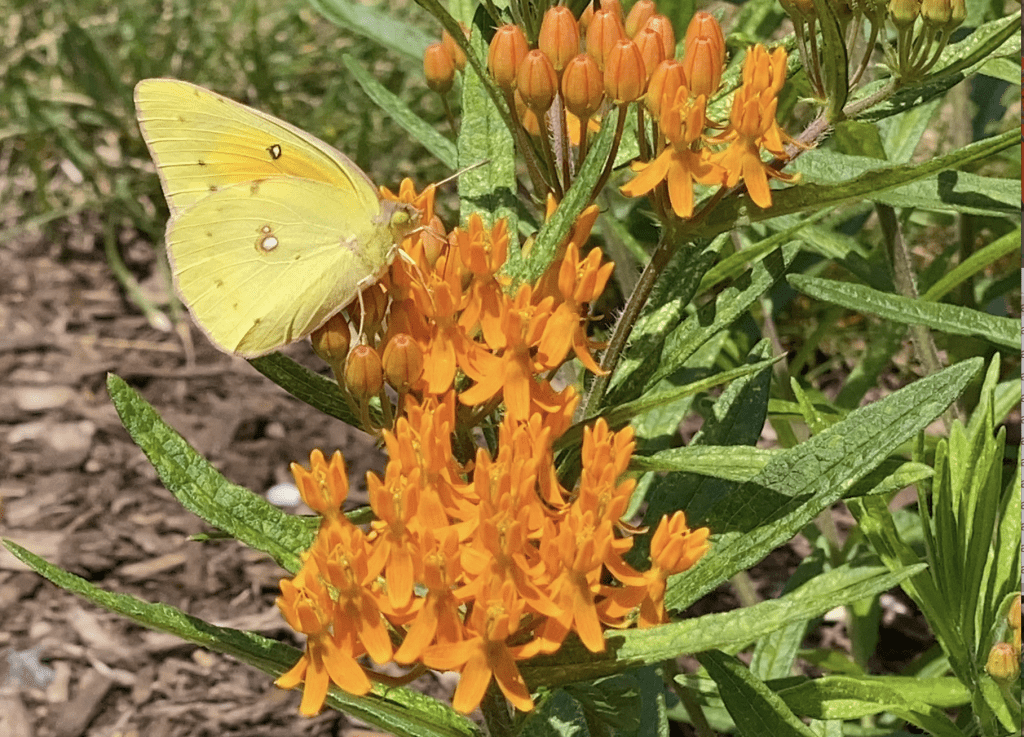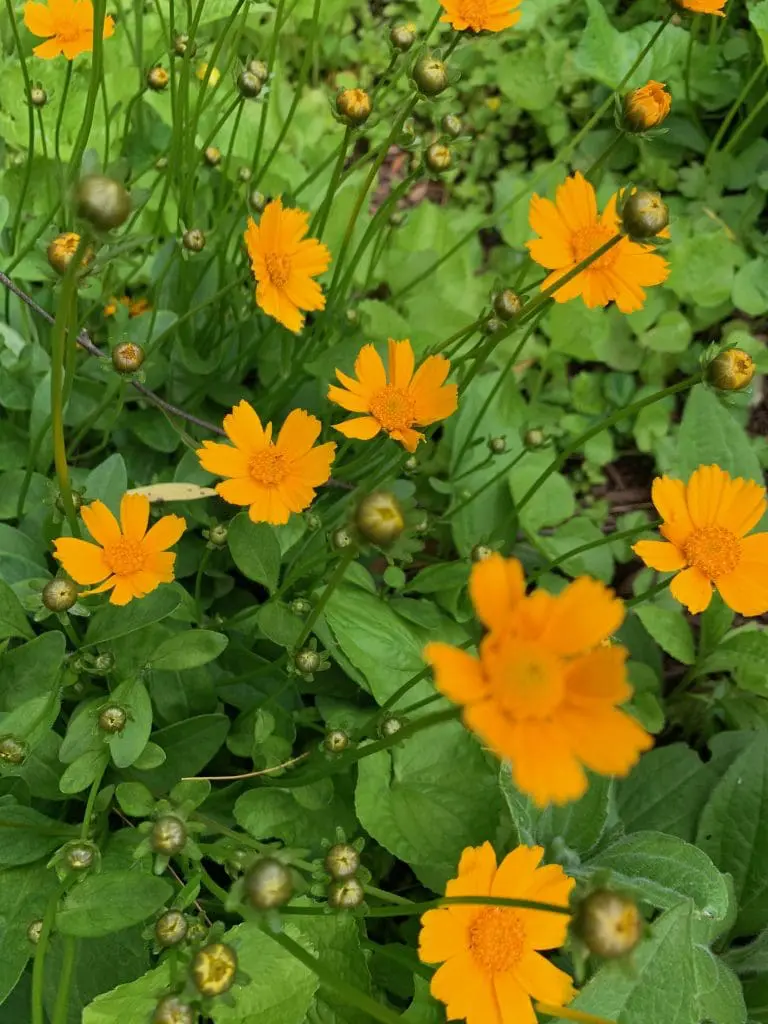It’s no secret that we at Green Jay Landscape Design firmly believe in restoring and designing native landscapes. Planting native plants has SO many ecosystem benefits –these ancestral plants adapted to difficult site conditions, provide critical soil stabilization, and of course, co-evolved with our local wildlife as the foundation of the food chain! We take a deep dive into our FAVORITE native perennials for the tri-state area (NY, NJ & CT). All of these native perennials are low maintenance, attract beneficial insects or birds, and look fabulous in landscapes of any size!

Cardinal Flower
Lobelia cardinalis
We’re going in rainbow order (obviously) and starting off with one of the best and brightest native wetland perennials!
Vibrant RED blossoms on 2-4’ spikes. Flower shape is tubular and called a two-lipped corolla.
Blooms July – September.
Naturally grows in North American wetlands, marshes, stream banks, low woods & wet meadows. We love to plant along ponds, streams & waterfalls, as in this photo!
As a Marginal Wetland Plant, Lobelia helps filter pollutants and excess nutrients from waterways.

Important food source for Hummingbirds, which are attracted to red blossoms & have long tongues especially adapted to tubular flowers.
Also attracts butterflies (Black Swallowtail, Spicebush Swallowtail, Pipevine Swallowtail), moths, bees and other pollinating insects and bird.
Grown best in full sun to light shade. Can take moist soil conditions up to (~2”) standing water, avoid letting the roots dry out!
Herbal Medicine: used by Iroquois to treat fevers & upset stomach and by the Delaware to treat typhoid & syphilis. Other tribes used it in tobacco ceremonies and as a love potion.
Bellflower Family (Campanulacea)
Coneflower
Echinacea purpurea
Perhaps the most recognized native plant! Hailing from the central prairies to meadows & woodland edges along the east coast, Coneflower is easily grown, long blooming, and a FAVORITE of pollinators. Plus, it comes in many cultivars (

Attracts BEES including: sweat bees (first video), bumble bees, wasps, mason bees, leaf cutting bees & more.

Attracts BUTTERFLIES including: fritillaries, monarchs, painted ladies, skippers, viceroys, American ladies, painted ladies, & swallowtails.

Attracts BIRDS including: goldfinches, blue jays, cardinals & hummingbirds. Leaving Coneflowers up through winter provides an important fall & winter food source (seeds) for birds.
Blooms June – August.
1.5 – 3’ Tall.

Full Sun (best) to Partial Sun. Medium moisture. Lean soils — go easy on the compost and no need to fertilize!
ETHNOBOTANY: Used by Native Americans for sore throats, quenching thirst, stomaches, toothaches, tonsillitis, & pain relief. Believed to be the most harvested & used medicinal plant of the Great Plains! Today it is still drank as a tea to support the immune system and reduce inflammation.
**A Note on Cultivars**
There’s been much debate about the place for cultivars in a native landscape, whether they serve the same benefits as the true native species. From our research, double-petaled cultivars are usually sterile or have inaccessible nectar/pollen— not beneficial for pollinators! AVOID DOUBLE PETALS.

Other claims of nutrient deficiencies in single petal cultivars have simply not been studied enough. In our personal field experience, we see plenty of bees, butterflies & birds on the white, red & slightly larger coneflower cultivars we’ve planted throughout the years. What we plant is greatly based on local availability, and cultivars of perennials are often more common than the true natives in nurseries.
We welcome more research on the topic, the intersection with pollinators, and more transparency in breeding!

Bee Balm & Wild Bergamot
Monarda didyma & Monarda fistulosa
The Monarda genus is known for its distinct “mophead” flowers ranging from scarlet red to hot pink to lavender. Monarda is a cult favorite #nativeplant because it is a bird and pollinator MAGNET, a repeat bloomer, deer resistant & has culinary uses!
Full Sun to Part Shade
2-4’ tall.
M. didyma naturally grows along stream banks and in lower, wetter environments. Wet to Medium soils.

M. fistulosa’s native habitat includes parries, dry rocky areas, and roadsides. Dry to Medium soils.
Attracts: BEES (sand wasps, sweat bees, bumble bees) BUTTERFLIES (monarchs, swallowtails), MOTHS (hummingbird moths, sphinx moths, grey marvel) & BIRDS (sparrows, goldfinches, hummingbirds)
Deadhead or prune part of the plant for repeat blooms but leave the final round of blossoms up through fall and winter! Monarda flowers produce a “nutlet” that birds such as sparrows and goldfinches feed on over winter.
Mint family — can be aggressive.

Wild Bergamot (M. fistulosa) foliage has a similar flavor to Earl Grey Tea and can be used in baking. M. didyma foliage has a savorier flavor, comparable to oregano and used in similar applications.The common name Bee Balm actually refers to the Native Americans use of monarda leaves in a poultice to treat bee stings.

Butterfly Weed
Ascelpias tuberosa
Native to all of the US except for the Northwest, butterfly weed is a fabulous low-maintenance, long-lived perennial that has co-evolved with many specialized wildlife species to provide critical habitat.
1 – 2.5’ Tall. Full sun to part shade. Dry to medium soils. Great rain garden plant!
ATTRACTS POLLINATORS:
- Monarch, Grey Hairstreek, swallowtails and Queen butterflies.
- Large milkweed bug, common milkweed bug, red milkweed beetle, blue milkweed beetle, Long-tongued bees
- Moths
- Hummingbirds
Monarch butterflies will ONLY lay their eggs on Ascelpias leaves. Monarch caterpillars feed on the leaves because the cardiac glycosides compounds they contain act as a chemical defense predators avoid the caterpillars because of their foul tasting flesh.

Butterfly Weed has a rich history of medicinal and ethnobotanic uses
Fibers such as rope, yarn and fabric
Used to treat swellings, rashes, diarrhea, blindness, for mothers to produce breast milk, snake bites, and as a contraceptive
The uncooked roots and green pods were eaten by the Pueblo tribes. However, cardiac glycosides are now known to be poisonous to both humans and livestock.
Avoid transplanting your butterfly weed plants. They have a tap root that is difficult to dig up and transplant successfully.
Member of the Apocynaceae or dogbane family.

Tickseed
Coreopsis spp.
A staple in many of our native plant gardens! Coreopsis is a repeat bloomer and very drought tolerant, aka, it looks fabulous all summer and into fall! We love to use it in front as a border with other low-growing natives like Geranium and Gallardia. Here’s what else we love about this native perennial:
1-3’ tall. Full Sun. Dry to Medium soil moisture.
Attracts many “beneficial insects” that naturally predate on garden pests. The natural pest control comes from: pirate bugs, parasitic wasps, hover flies, soldier beetles, syrphid flies, lacewings, and spiders. Check out Attracting Beneficial Bugs by Jessica Walliser for more info!

Nectar plant for butterflies including: Monarch, Common Buckeye, Eastern Tailed-Blue.
Pollen source for both native bees (long-tongued bees, short-tongued bees, wasps) and honey bees.
BLOOMS: mid-summer to Fall.
Beautiful, unique needle-like folliage, especially Coreopsis tripteris.
DEER TOLERANT!
Coreopsis lanceolata self-seeds / naturalizes easily, making it great for meadows and larger regeneration projects.
Ethnobotany: Used by Native Americans to treat many maladies including internal pain (boil flowers and drank as tea), diarrhea (root tea), and as an emetic. Flowers were also used to make yellow and red dyes.

Sneezeweed
Helenium autumnale
Happy to report the namesake of this native perennial beauty does not refer to allergies or hay fever! In fact, dried sneezeweed flowers were traditionally used to induce sneezing. Sneezes were thought to aid head colds as well as dispel evil spirts from the body.
Plus, Helenium is insect-pollinated, not wind-pollinated. It is the airborne pollen of wind-pollinated plants like ragweed that tend to induce hay fever symptoms.

What pollinators are attracted to Helenium?!
Countless pollinators & beneficial insects including: halictid bees, bumble bees, sweat bees, wasps, honey bees, syphrid flies, hover flies, ants, skippers, and sulphur butterflies (host plant). Many birds feed on Helenium seeds in late fall and winter.
Full sun to part shade. Dry to medium moisture.
2-3’ tall.
Blooms late summer – early fall.

Helenium refers to Helen of Troy. Legend has it these flowers appeared where her tears fell.
Leaves and flowers are poisonous to humans if eaten in large quantities, because of chemicals called sesquiterpene lactones. These compounds also make helenium DEER & RABBIT RESISTANT!

Black-eyed Susan
Rudbeckia spp.
An ICON in the native plant world, Rudbeckia can do it all! Its tolerant of a range growing conditions, is fast growing and low maintenance.
Plus, Rudbeckia is one of the longest-blooming perennials we know (!!), providing essential nectar and pollen from July to October. When the spent flowers turn to seed, its feasting time for many species of native birds. (Exactly why we insist on leaving native perennials up thru fall and winter!)

Rudbeckia looks fabulous with Echinacea, Agastache, Monarda, Asters, Switchgrass and countless other native perennials & grasses for a high-impact ecological landscape.
2’ -3’ Tall & fast growing.
Full sun (preferred) to part shade. Dry to Moist/Wet soils = great rain garden plant!
BIRDS that feed on Rudbeckia seeds include: American Goldfinch, Black-Capped Chickadee, Northern Cardinal, White-Breasted Nuthatches, Sparrows, and Eastern Towhee.

BUTTERFLY host plant for the Silvery Checkerspot caterpillar. Many other native Lepidoptera (butterflies & moths) visit Rudbeckias for nectar.
BENEFICIAL INSECTS are attracted to Rudbeckia, including Syrphid Flies, spiders, Ambush bugs, and Scolid wasps.
TRADITIONAL MEDICINAL Rudbeckia has a long herbal history for Native American tribes. Flower petals were boiled into a tea and used as a diuretic, and to treat edema, cardiovascular problems, and worms. Root “juices” were used to treat earaches. Topically, it was used as a wash on snakebites, burns, and wounds. Today, Rudbeckia tonics and teas are still consumed as an immune-booster.

OXEYE SUNFLOWER / FALSE SUNFLOWER
Heliopsis helianthoides
We love the elegant branching structure of Heliopsis and its high ecological impact — from habitat building to erosion control!
3-6’ tall
Dry to medium soil. Full sun is best, but can tolerate part shade—and may require staking.
Blooms July to September/October.

Fast growing & naturalizing, Heliopsis is ideal for soil stabilization on slopes, as seen in the above photo. This garden drops off abruptly and is susceptible to erosion. We removed the existing invasives and planted a mass of Heliopsis behind native flowering Viburnum shrubs.
Native to eastern & central US. Naturally found in prairies, fields and forest edge.
ATTRACTS POLLINATORS including:
Bees – bumblebees, miner bees, carpenter bees, digger bees, honeybees, cuckoo bees, leaf-cutting bees, halictid bees & goldenrod solider bees
Butterflies – Painted ladies, rigid sunflower borer moth & more
Birds – hummingbirds, finches, sparrows and juncos
Many beneficial insects overwinter in the stems of the Heliopsis. Leave your perennials up!
MEDICINAL Traditionally, Heliopsis has been brewed into a tea or tonic to treat lung ailments, fevers and colds. The stems have been used to treat malaria.
Asteracea, the Sunflower family.

GOLDENROD
Solidago spp.

Pollinators attracted to goldenrod (a sampling of many): sphinx moths, hummingbird moths, honey bees, native bees, wasps, monarch butterflies, red-banded hairstreak butterflies, and beneficial insects such as ants, spiders and praying mantises!
For shadier areas try S. caesia (Wreath Goldenrod) or S. flexicaulis (Zigzag Goldenrod)
Goldenrods have a rich ethnobotanic and medicinal history. Some Native American tribes like the Lenni Lenape used goldenrod in sweat lodge ceremonies. Ojibwa used it to treat fevers, ulcers, boils and cramps. The Blackfoot employed it for congestion and sore throats.
Many people misattribute goldenrod as their seasonal allergies. As discussed previously, insect-pollinated plants do not have airborne pollen that triggers allergies! Ragweed is generally the culprit and blooms at the same time as goldenrod.
All goldenrods are yellow except for S. bicolor which is white!


The above photos were taken at a wet meadow we manage in South Salem. It was previously a lawn until we stopped mowing and let the native seed bank do its thing. Always worthwhile to see what Mother Nature pairs together.
Stay tuned for more of our favorite native perennials for the northeast in Part Two of the blog – coming soon!
—
Green Jay Landcaping
914-560-6570